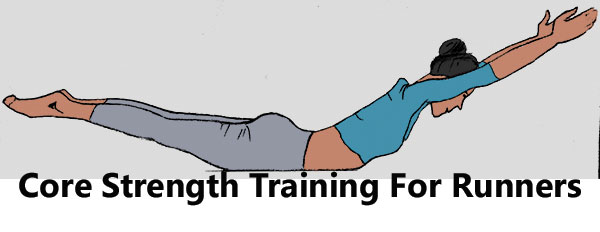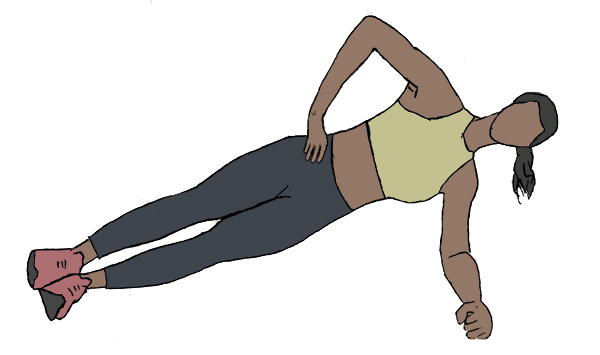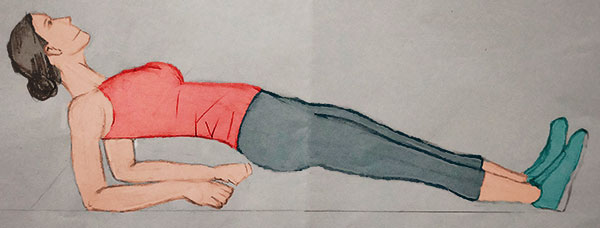
In this post, we’ll learn about which muscles are part of our core, why it’s important to have a strong core and some of the best core exercises for runners.
Why is Core Strength Important for Running
We use our core for everyday activities without even thinking about it. Whenever we bend, twist, sit down, stand up or move; we use our core.
You can also think of your core as the trunk of a tree as it connects your upper and lower body. And the strength of the core determines how well your arms and legs move.
Generally, a weak core is associated with lower back pain and bad posture. But for runners, a weak core can cause a lot of trouble.
For example, poor pelvic stabilization often causes knee problems. Weak hip muscles cause hips to dip too low while running. Since a weak core can’t handle the landing shock while running, some runners develop neck and back pain. Other muscles have to compensate for the weak core muscles. This causes the runner to run with a bad running technique. As a result, she will be less energy efficient and more likely to get injured.
I don’t mean to scare you, but to give you the idea about the importance of a strong core. If you have been active, the chances are your core is going to be strong enough (at least for the type of activities you’ve been performing). Since we know that running is quite a demanding activity, you should make sure that you have a strong core.
Now, it’s unfortunate that most people (including runners) pay attention to only abdominal muscles (six-pack abs) – ignoring the rest of the core. It’s important to understand that your core is made up of several muscle groups, which are:
- Abdominal muscles
- Oblique muscles
- Lower back muscles
- Pelvic muscles, and
- Buttocks
All these muscles work together to stabilize your body when you run or perform any activity. Working only on abdominal muscles can create muscular imbalance, which, of course, isn’t what we want.
Now, the good news is – strengthening your core isn’t hard. As I mentioned earlier, if you keep running or doing other types of training (e.g. strength training), your core strength will improve. Additionally, you can perform some core-specific exercises into your routine. And the best part is, these exercises are easy to incorporate into your training as they can be done without any special equipment.
In the next section, we’ll look at some popular core exercises that help runners. But first, consider the following:
- If you have back pain or any other problem, you should seek help from a medical professional first as there are many reasons that can be the cause. A medical professional will assess your problem and recommend specific exercises that will address your problem.
- Start with the basic exercises first, don’t attempt hard ones only because they look cool.
- Focus on the correct technique. Performing these exercises with correct form is more important than the number of reps or duration. For example, if you can’t hold a plank for one minute, start with twenty seconds. Slowly increase the duration when a 20-second plank feels easy. You don’t have to torture yourself every single time as it makes the workout unenjoyable. It’s not very motivating, is it?
- Try to breathe normally throughout the exercises. This is a bit hard but it’ll get easier with practice.
How Much Time Should You Spend on Core Exercises?
Most runners run a lot and sometimes they barely have time for performing any additional work. The good thing is, you don’t have to spend a lot of time on core exercises to get the benefits.
Performing core work 2-3 times each week is sufficient.
You can either perform a core routine separately or include a couple of core exercises into your strength routine. Personally, I like the latter approach as it saves time, but you can experiment and find out what works for you.
Best Core Exercises for Runners
Here are some popular core exercises that are simple yet effective. I have also listed harder variations for some exercises that you can do after getting comfortable with the first variation. For example, when you can easily perform a plank for one minute, try Plank With Single-Leg Raises.
You get more challenge in the same amount of time. And it also gives you variety which keeps things interesting.
1. Elbow Plank

Begin with the push-up position. Rest on your forearms and toes. Engage your abdominal muscles and hold this position for 20-60 seconds. Make sure you keep your body in a straight line during the whole exercise, it shouldn’t sag down or arch up. Also, keep your neck neutral.
Harder variation:
Plank With Single Leg Raises
While holding the plank position, raise one of your legs upwards and hold for about one second. Then bring it down and repeat with the other leg. Perform 5-10 leg raises with each leg.
2. Side Plank

Rest on your left forearm and left leg. Place your elbow right below your shoulder. You can raise your right arm straight up towards the ceiling or place it on your hip. Again, keep your body in a straight line and hold this position for 20-60 seconds. Repeat on the other side.
Harder Variation:
Side Plank With Single Leg Raises
While holding the left side plank, raise your right leg upwards, hold a bit, and then bring it back to its original position. Repeat 5-10 times.
3. Reverse Plank

In a reverse plank, your weight should be supported by your forearms and heels. Engage your core and keep your body in a straight line. Hold the position for 20-60 seconds.
Harder Variation
Reverse Plank with Leg Lifts
From a reverse plank position, raise one of your legs a few inches off the ground. Hold a bit and then lower it. Perform 8-10 reps with each leg.
Notes on Plank Variations:
- To make the plank more challenging you can rest on your hands (palms on the ground) during all these plank variations. But start with your forearms as it’s quite difficult already.
- You should aim for a one-minute duration for all these plank variations. Or two minutes max if you really want to hold a plank for a long time. There is no benefit of going beyond that, you should rather perform harder variations. Perform them with correct technique and you will be busy for a long time.
- Don’t hold your breath, try to breathe normally. You may find this hard in the beginning but like all things, it gets easier with practice and experience.
4. Hollow Hold

Lie on your back. Extend your arms. Then raise your shoulders and legs a few inches off the ground. Your lower back should be down on the mat. Hold for 30 seconds.
5. Superman Hold

Lie facedown. Raise your arms and legs a few inches off the ground while keeping them extended. Keep your pelvis on the mat. Hold this position for 30 seconds.
6. Glute Bridge
Lie on your back, bend your knees, and keep your feet on the ground. Keep your arms at your sides or across your chest.
Engage your abdominal muscles and raise your butt off the ground until your chest and knees are in a straight line. Hold for 3-5 seconds then come back down to the original position. Repeat 10-15 times.
Harder Variations:
Single-Leg Bridge – Raise and extend one of your legs, then raise your butt off the ground until your chest and knees are in a straight line.
Single-Leg Glute Marching – After you raise your butt off the ground as in a normal glute bridge, alternate raising your legs. Focus on proper alignment and repeat 10-15 times with each leg.
Bridge Walkouts – After raising your butt off the ground, walk your feet out slowly. Keep your hips up, continue to a suitable distance, and then slowly walk back to your starting position. Repeat 12-15 times
7. Abdominal Crunches
Lie on your back with your knees bent and feet on the ground. Place your hands behind the head or across the chest. If you place them behind your head, make sure they’re just supporting your neck lightly and not pulling your head up. Now, Engage your abdominal muscles and slowly raise your shoulders off the ground. Hold this position for a few seconds and then lower back down. Perform 15-20 reps.
Some people raise their upper body too much thinking it will be better but it isn’t. One way to do the crunches right is raising up toward the ceiling and not toward your legs. You need to raise your shoulders only 1-2 inches off of the ground. And try to breathe out as you go up and breathe in as you come back down.
8. Superman Crunches
This is similar to superman hold but the only difference is you will do reps instead of holding the position.
Lie facedown with your legs straight and arms outstretched in front of you. Raise your arms and legs a few inches off the ground. Slowly return to the starting position to complete one rep. Perform 15-20 reps.
9. Donkey Kicks
Start in a table position, your hands should be directly under your shoulders and your knees under your hips. Lift one leg off of the ground until the thigh is parallel with the floor, keeping your knee bent at 90 degrees. Then return to the starting position. That’s one rep. Perform 10-15 reps, then repeat with the other leg.
This exercise is great for hip strength, you can check out other similar exercises in the Myrtl routine.
References:
